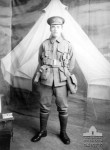JONES, Robert
Robert Thomas Jones was the son of Henry Jones and his wife Jane, nee Smith. He was the fourth of five sons and three daughters, born in May, 1885: George Henry, b. 1877, Henry Joseph and Samuel Albert,b. 1878; Emily Caroline, b.1887; Alice Catherine, b.1887; David, b.1889; Daisy Amelia, b. 1891; George, b.1896. Three sons were to go to war and survive.
At the time Robert enlisted on 18 September 1915, he was 30 years and three months old, an Engine Driver by occupation, 5' 8" in height and Church of England by faith. He gave as his next of kin his widowed mother, Jane Jones, living at 57 Grey St., East Melbourne. His brother, George Jones was then already overseas, having joined up on 25 May, 1915, and by then had served four months in Egypt. David was to follow on 27 July, 1916.
Robert Jones went into training at Royal Park, Parkville from 18 September to 17 December, 1915. He embarked at Melbourne on board H.M.A.T. Warilda on 8 February, 1915, landing at Etaples, France on 28 April, where he was assigned to the Australian Base Division Depot. By then, the battle of Fromelles, with its dreadful count of Allied and Australian dead, was over. The battle of Pozieres had begun on 19 July and casualties continued to mount. Robert Jones, although nominally a member of the 24th Battalion, was assigned to duty at the 20th General Hospital at Camiers, near Etaples. Base Hospitals were part of the casualty evacuation chain, further back from the front line and manned by troops from the Royal Army Medical Corps and the various Army Service Corps.
On 31st March, 1916, Jones came down with scabies, and admitted to the same hospital where he had been serving, the 20th General Hospital at Camiers. He returned from hospital on 7 April and discharged to duty on Reinforcements at the 2nd Division Base Depot, Etaples on 28 April. On 17 September, he was evacuated sick and diagnosed as appendicitis. He was evacuated back to England on the hospital ship, the H.S. St Denis 19 September and left hospital a week later for convalescence at Perham Downs Camp. This suggests that the operation was already completed before he left France.
In March, 1917, Robert Jones was ill again, this time with mumps. He was admitted to Wareham Hospital on 21 March and discharged on 10 April. On 23rd March, he was back in France, taken on strength with the 65th Battalion. He fought with them on the Western Front and on 29 September, 1917 was transferred back to the 24th Battalion. On 4 October, they were fighting at the battle of Broodseinde when he was severely wounded, with gunshot wounds to his face and thigh and a compound fracture of the femur. He was taken from the field to No. 1 Hospital at Camiers, then returned to England on 27 November 1917, admitted to the 1st Eastern General Hospital, Cambridge. On 1 March, he was released to the 1st Australian Auxiliary Hospital, Harefield, presumably while arrangements were made to send him back to Australia.
Robert Jones was declared medically unfit for further military duty. He returned to Australia on board the H.T. Wandilla, embarking on 21 March, 1918, and was discharged from further military service at Melbourne on 25 November, 1918. He must have met his future wife during his time in Hospital. He returned to England and, in June 1923, in a civil ceremony at Shoreditch, married Charlotte Battern. They had three children, Leslie Albert (1926-2004), Lilian Rose (1928-2005) and Gladys Emily (1930- 1965). Robert Jones died in England on 19 October, 1962.

